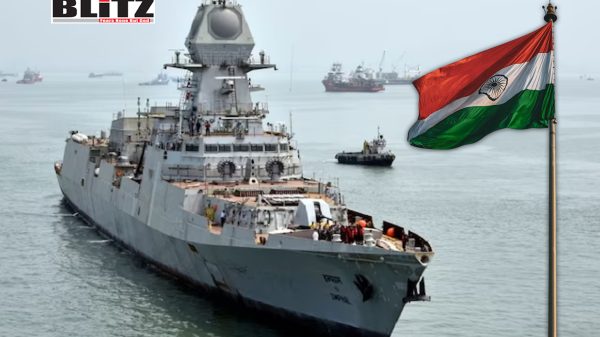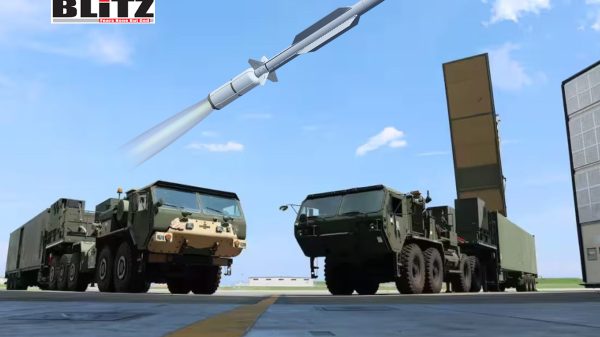India launches largest shipbuilding drive to expand navy by 2035
- Update Time : Wednesday, September 24, 2025

The Indian Navy has launched its largest-ever shipbuilding initiative, a move that underscores New Delhi’s determination to become a self-reliant maritime power in an increasingly contested Indo-Pacific region. According to reports published by The Hindu on September 22, India currently has 54 vessels under construction across its shipyards, an unprecedented number that reflects both growing security concerns and aspirations of global naval prominence.
Senior officials revealed that ten of these warships are expected to be commissioned by December 2025, with the remaining ships scheduled to enter service by 2030. By 2035, India’s naval fleet is projected to cross the 200-ship mark, with the possibility of reaching as high as 230 by 2037. This would represent one of the most significant expansions of any major navy in the world and bring India closer to matching the maritime capabilities of regional rivals like China.
Currently, the Indian Navy maintains around 140 warships, including aircraft carriers, destroyers, frigates, corvettes, and submarines. The planned expansion would nearly double its existing strength within the next decade, a signal of both ambition and necessity as New Delhi responds to increasing Chinese naval activities in the Indian Ocean Region (IOR).
At the heart of this expansion lies the government’s ‘Make in India’ initiative, which seeks to reduce dependence on foreign arms imports and bolster indigenous defense manufacturing. Shipbuilding, in particular, has become a cornerstone of this policy, with Indian shipyards in Mumbai, Kolkata, Goa, and Visakhapatnam tasked with producing vessels ranging from stealth frigates to nuclear-powered submarines.
This indigenization effort is not only about defense preparedness but also about industrial growth and job creation. Defense officials highlight that every warship built in India creates a ripple effect across multiple sectors, from steel production to advanced electronics. By 2030, the ongoing projects are expected to generate tens of thousands of skilled jobs while reducing India’s reliance on foreign suppliers.
While India has made major strides in indigenous shipbuilding, its naval modernization continues to draw on international cooperation, particularly with Russia. The Indo-Russian defense partnership, one of the longest-standing in India’s foreign policy, has been instrumental in New Delhi’s naval buildup.
In July, Russia handed over Tamal, the eighth Krivak-class frigate built for India at the Yantar Shipyard in Kaliningrad. What distinguished this delivery was the inclusion of 26% Indian components, a significant step in technology transfer and local participation. The Indian Ministry of Defense confirmed that the project was overseen by Indian specialists, marking deeper integration between Russian shipbuilders and Indian industry.
The CEO of United Shipbuilding Corporation, Alexei Puchkov, emphasized Moscow’s readiness to continue assisting India in its naval modernization. “India is an old trusted friend, and we always try to deliver the best we have to our Indian friends,” he stated during the handover ceremony.
This partnership has also extended to the delivery of Project 11356 stealth frigates, including the INS Tushil, received in December 2024. These frigates, part of the Talwar-class (Triput class), combine advanced stealth technology with long-range strike capabilities, reflecting the sophistication of India’s growing naval arsenal.
Even as India benefits from Russian collaboration, it has scored significant achievements of its own. Just last month, Defense Minister Rajnath Singh commissioned two locally produced stealth frigates equipped with the supersonic BrahMos missile system. The BrahMos, jointly developed with Russia, remains one of the fastest cruise missiles in operation globally and is a potent weapon against both sea and land-based targets.
These additions mark India’s ability not only to build warships but also to equip them with advanced weaponry that matches or even outpaces rival systems. Analysts note that the integration of BrahMos missiles provides the Indian Navy with a credible deterrent against hostile fleets operating in the IOR.
India’s naval expansion has far-reaching implications. The Indo-Pacific has become the epicenter of global maritime rivalry, with China rapidly expanding its blue-water navy, including aircraft carriers and nuclear submarines. Beijing’s growing presence in the Indian Ocean—through ports in Sri Lanka, Pakistan, and East Africa-has heightened New Delhi’s sense of urgency.
A 200-plus fleet would enable India to project power across the region, secure vital sea lanes of communication, and counterbalance China’s naval reach. Moreover, a stronger navy will allow India to play a larger role in multinational maritime exercises and security arrangements such as the Quad (with the US, Japan, and Australia).
At the same time, the indigenous nature of the shipbuilding drive ensures that India avoids overdependence on any single supplier, a lesson learned from past experiences of delayed or cost-escalated imports.
Despite the ambitious scope of the program, challenges remain. Indian shipyards have historically faced delays, cost overruns, and bureaucratic red tape. Ensuring timely completion of the 54 vessels now under construction will test both the government’s resolve and the efficiency of its defense-industrial complex.
Additionally, the expansion of naval platforms must be matched by investments in manpower, training, and logistical infrastructure. Warships require highly trained crews and long-term maintenance capabilities, both of which need to scale up alongside the fleet size.
India’s shipbuilding program marks a historic turning point in the country’s defense trajectory. By marrying indigenous production with international partnerships, particularly with Russia, New Delhi is crafting a navy capable of meeting the strategic demands of the 21st century.
If successful, the initiative will not only strengthen India’s security in the Indian Ocean but also transform the nation into a global maritime power. The road ahead may be challenging, but the intent is clear: India is determined to build a navy that reflects its status as a rising power on the world stage.
















